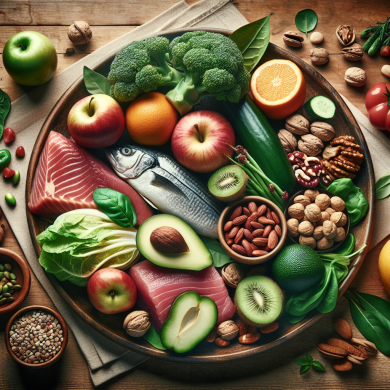Paleo vs. Keto: A Comparative Analysis
Introduction
In the realm of dietary trends, the Paleo and Keto diets have garnered significant attention. Both emphasize nutrient-rich, whole foods and have been associated with various health benefits, including weight loss and improved metabolic function. However, they differ in their core philosophies and nutritional guidelines. This article explores these two popular diets, comparing their principles, benefits, and potential drawbacks.
Understanding the Paleo Diet
Core Principles
The Paleo diet, often described as the “Caveman Diet,” focuses on consuming foods that our Paleolithic ancestors might have eaten. The rationale is that modern humans should follow a diet that aligns with their genetic makeup, emphasizing whole, unprocessed foods.
The Paleo diet primarily includes lean meats, fish, fruits, vegetables, nuts, and seeds. It excludes dairy, grains, legumes, processed foods, and refined sugars. Proponents believe that by avoiding these foods, one can reduce the risk of chronic diseases linked to modern lifestyles.
Benefits
Advocates of the Paleo diet argue that it can lead to weight loss, improved glucose control, and reduced risk factors for heart disease. The diet is rich in nutrients due to its emphasis on fruits and vegetables, and its high protein content can help in muscle maintenance and satiety.
Drawbacks
Critics of Paleo suggest that excluding entire food groups like grains and dairy may lead to nutrient deficiencies, such as calcium and fiber. Additionally, the emphasis on meats can lead to an increased intake of saturated fats, which some studies associate with heart disease.
Understanding the Keto Diet
Core Principles
The ketogenic (Keto) diet is a high-fat, low-carbohydrate diet designed to shift the body’s metabolism from using glucose as its primary energy source to using ketones, a state known as ketosis. By significantly reducing carbohydrate intake, the body is forced to burn fat for fuel.
The Keto diet includes foods high in fats, such as avocados, nuts, seeds, oils, and fatty fish, while restricting carbohydrates found in grains, legumes, fruits, and starchy vegetables. Moderate protein intake is also a component of the diet.
Benefits
The Keto diet is well-known for its effectiveness in rapid weight loss and improved blood sugar control. It has also been used in medical settings to manage epilepsy and is being researched for its potential benefits in other neurological disorders.
Drawbacks
The restrictive nature of the Keto diet can lead to nutrient deficiencies and adverse effects like the “keto flu,” characterized by fatigue, headaches, and nausea. Long-term adherence can be challenging, and there are concerns about increased cholesterol levels due to high fat intake.
Paleo vs. Keto: A Comparative Analysis
Macronutrient Composition
One of the most significant differences between the Paleo and Keto diets lies in their macronutrient compositions. The Paleo diet does not specify macronutrient ratios but naturally tends to be higher in protein and moderate in carbohydrates and fats. In contrast, the Keto diet has a specific macronutrient breakdown: high fat (about 70-80% of total intake), moderate protein, and very low carbohydrates.
Food Groups
Both diets emphasize whole, unprocessed foods, but they differ in terms of allowable food groups. Paleo allows for more carbohydrate sources like fruits and some tubers, while Keto restricts these in favor of fats. Both diets exclude grains and legumes but for different reasons: Paleo due to evolutionary dietary theories and Keto to maintain ketosis.
Health Impacts
Both diets have been linked to weight loss and improved metabolic health, but they achieve these outcomes through different mechanisms. Paleo’s benefits are attributed to eliminating processed foods and focusing on nutrient density, while Keto’s are due to metabolic changes from ketosis.
The long-term health impacts of both diets require further research. Some studies suggest potential cardiovascular benefits from Keto due to weight loss and improved lipid profiles, but concerns remain about its high saturated fat intake. Paleo is generally considered more sustainable over the long term due to its less restrictive nature.
Cultural and Lifestyle Considerations
Adhering to the Keto diet requires careful planning to maintain ketosis, which can be socially and culturally challenging, especially in carb-centric societies. Paleo, while still requiring dietary changes, often aligns more closely with traditional dietary patterns and may be easier to maintain in various cultural contexts.
Suitability for Different Individuals
The suitability of either diet depends on individual health goals, preferences, and medical conditions. Keto may be more appropriate for those seeking rapid weight loss or managing specific health conditions like epilepsy. On the other hand, Paleo might be better for those looking for a more balanced approach to eating that includes a variety of food groups.
Conclusion
Both the Paleo and Keto diets offer unique approaches to health and nutrition, each with its strengths and limitations. Choosing between them depends on personal health goals, lifestyle preferences, and individual response to dietary changes. It is essential to consult healthcare professionals when making significant dietary alterations, especially for those with existing health conditions.
Ultimately, while both diets can lead to weight loss and improved health markers, a balanced approach that incorporates the best aspects of each diet may provide optimal health benefits. By focusing on whole, nutrient-dense foods and tailoring macronutrient intake to individual needs, one can achieve long-term health and wellness.















Add comment